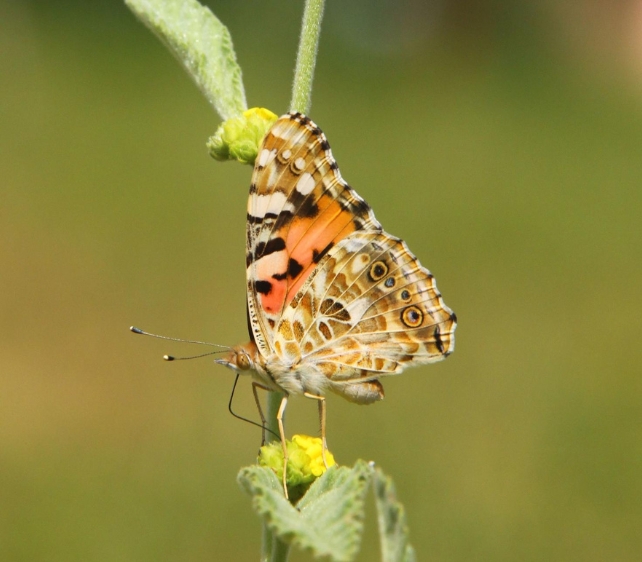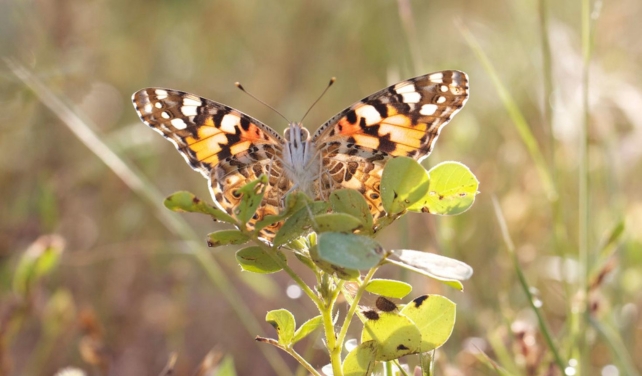Some butterflies can cross entire oceans with the help of the wind.
A world-first study has now shown that the Painted Lady (Vanessa card) can cross the world’s second largest ocean, the Atlantic Ocean, covering a distance of 4,200 kilometers in just five to eight days.
The researchers claim the journey is “one of the longest documented journeys for individual insects, and possibly the first verified transatlantic crossing.”
This incredible discovery was made after more than ten years of mystery.
It all began in 2013, when a swarm of tired butterflies, their wings torn and ripped, landed on the beaches of French Guiana. Entomologist Gerard Talavera, who saw the insects resting on the sand early one October morning, was shocked.
These were Painted Ladies, a common species with stable populations found on every continent except Antarctica and South America.
For years, Talavera kept wondering: How did the insects get to South America and where did they come from? Finally, he has an answer.

By analyzing the DNA of the pollen left on the butterflies, Talavera and his colleagues from the Botanical Institute of Barcelona showed that this lost swarm probably flew from sub-Saharan Africa, after a chance transatlantic journey.
It appears that the adult insects were caught in a strong trade wind in 2013 and blown 4,200 kilometers off course.
Judging by the trade winds that year, the journey would have taken the butterflies about five to eight days. With no place to land, the insects would have had to use their wings sparingly.
The researchers suspect that without the help of strong winds, the flock could have traveled only 780 kilometers before all its energy was used up and the birds would have died out.
“Our findings suggest that we may be underestimating the transoceanic dispersal of insects and highlight the importance of airways that connect continents through trade winds,” Talavera and his colleagues write.
The monarch butterfly (Danaus plexippus) is world famous for its nearly 5,000-kilometer migration from North America to Mexico each year, but Painted Ladies also make long journeys between Europe and Africa each year. Some studies suggest that a single generation can migrate more than 4,000 kilometers.
This would make it the butterfly with the longest migration time in its life. But unlike other animals that fly through the air, such as birds, it is much harder to track the global movements of small creatures such as insects.
The wings of the Painted Ladies in French Guiana were found to contain isotopes that suggest they were born in Western Europe. This means that the swarm has travelled more than 7,000 kilometres in one lifetime and has visited no fewer than three continents.
“This is the first time that this combination of molecular techniques, including isotope geolocation and pollen metabarcoding, has been tested on migrating insects,” said geochemist Clément Bataille of the University of Ottawa in Canada.
“The results are promising and transferable to many other migratory insect species. The technique should fundamentally change our understanding of insect migration.”
While the long-distance migration from Europe to Africa or North America to Central America is undoubtedly impressive, there are also plenty of places where butterflies can stop and refuel along the way. An ocean crossing is a different challenge altogether.

Painted Ladies may have wings the size of a pinky and a brain the size of a pinhead, but they are incredibly good at flying.
In fact, their small size gives them an advantage, allowing the species to glide on the wind, sometimes as fast as 48 kilometers (30 miles) per hour.
It’s not just these humble insects that scientists underestimate.
The winds that blow across the Atlantic Ocean from the Sahara to the tropical Caribbean are stronger than experts once thought, carrying large dust particles as far as 3,500 kilometers.
It makes sense that a small winged creature could travel a considerable distance with minimal effort by gliding on this wind.
“Normally we see butterflies as symbols of the fragility of beauty, but science shows that they can perform incredible feats,” says entomologist Roger Vila of CSIC-Pompeu Fabra University in Spain.
“There is still much to discover about their capabilities.”
The research was published in Nature communication.
